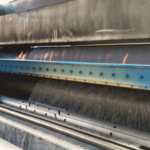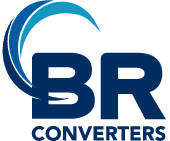Flame Lamination
40 years’ experience with flame lamination
In the flame lamination process, a substrate (primarily polyurethane foam) is passed through a controlled flame. This transforms the surface of the foam into a molten state. Then, using controlled tension and pressure (nip point), the molten foam is joined with another substrate or textile.
Using this process, flexible foams can be effectively bonded to a variety of other substrates, including fabrics, films, and papers.
The full surface bond that the Flame Lamination process creates is superior in strength, stability and appearance to other bonding processes. This is particularly the case when two or more materials are stacked in multiple layers.
Bi-Lamination & Tri-Lamination

Our Flame Lamination capabilities include both bi-lamination and tri-lamination processes.
These processes add a Cerex or Denier backing to provide greater stability to the textile. Making the textile more stable allows it to better hold the needle thread during final fabrication.
Possible Laminations:
- Polyurethanes to Fabric
- Polyurethanes to Vinyl
- Polyethylene to Foam to Foam to build up thickness
- Polyethylene to foam to foam
- Geonet to Geotextiles
Flame Lamination applications
By using flame lamination, the bonding process becomes more efficient and cost effective as the expense and complexity of glue application is removed from the bonding process.
Flame lamination is suitable in the manufacture of:
- Sound Attenuation
- Footwear
- Upholstery
- Sports and Gymnastics
- Insulation
- Automotive
- Military
- Office Partitioning
- Drapery
- Bedding
- Insulation
- Orthopaedic Braces
How we work
With over 50 years in the textile bonding and printing business in Australia we know how to make it easy for you.
Send us your fabric and an order form
Download your order instructions and form below.
We test the first meter for suitability
We will contact you if there are any problems with the test.
We maintain strict quality control
We quality control your project throughout the process.
We will deliver on budget and time
We will communicate with you to arrange the best delivery method.
NOTE: Work loss: please include with your order one additional meter for each continuous piece of material supplied.
NOTE: Fabric should be forwarded rolled on a tube with the face side of the fabric clearly marked. Incoming fabric that is wrinkled or not rolled on a tube will be subject to wrinkle removal charges.
